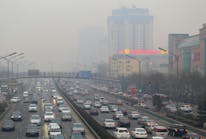Researchers at the National Institutes of Health found that living in an area with high levels of particulate air pollution was associated with an increased incidence of breast cancer. The study, published in the Journal of the National Cancer Institute, is one of the largest studies to date looking at the relationship between outdoor air pollution, specifically fine particulate matter, and breast cancer incidence. The research was done by scientists at the National Institute of Environmental Health Sciences (NIEHS) and the National Cancer Institute (NCI), both part of NIH.
The researchers saw that the largest increases in breast cancer incidence was among women who on average had higher particulate matter levels (PM2.5) near their home prior to enrolling in the study, compared to those who lived in areas with lower levels of PM2.5. Particulate matter is a mixture of solid particles and liquid droplets found in the air. It comes from numerous sources, such as motor vehicle exhaust, combustion processes (e.g., oil, coal), wood smoke/vegetation burning, and industrial emissions. The particulate matter pollution measured in this study was 2.5 microns in diameter or smaller (PM2.5), meaning the particles are small enough to be inhaled deep into the lungs. The Environmental Protection Agency has a website known as Air Now where residents can enter their zip code and get the air quality information, including PM2.5 levels, for their area.
The study was conducted using information from the NIH-AARP Diet and Health Study, which enrolled more than 500,000 men and women between 1995-96 in six states (California, Florida, Pennsylvania, New Jersey, North Carolina, and Louisiana) and in two metropolitan areas (Atlanta and Detroit). The women in the cohort were on average about 62 years of age and most identified as being non-Hispanic white. They were followed for approximately 20 years, during which 15,870 breast cancer cases were identified.
The researchers estimated annual average historical PM2.5 concentrations for each participant’s residence. They were particularly interested in air pollution exposures during a period of 10-15 years prior to enrollment in the study, given the length of time it takes for some cancers to develop. Most previous studies have assessed breast cancer risk in relation to air pollution around the time of study enrollment and did not consider past exposures.
To consider how the relationship between air pollution and breast cancer varied by the type of tumor, the researchers evaluated estrogen receptor-positive (ER+) and -negative (ER-) tumors separately. They found that PM2.5 was associated with a higher incidence of ER+ breast cancer, but not ER-, tumors. This suggests that PM2.5 may affect breast cancer through an underlying biologic pathway of endocrine disruption. ER+ tumors are the most common tumors diagnosed among women in the United States.





